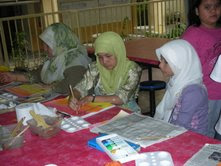For the love of art
2009/10/07
RICHARD Wee Guanlee, a Singaporean, went to London in 1975 to start a branch of Singapore's United Overseas Bank (UOB).
Two years after leaving UOB, Wee assisted DBS Bank to open a branch in London in 1982.
But Wee was not destined to remain a banker for long as he would sneak to the City of London Library during lunch -- whenever he had time -- to go through the volumes of art books.
Then he started going to evening classes in London to learn to paint in water colours. By then, there was no turning back. Wee had rediscovered his first love -- art.
The self-made artist says: "My attitude was that of a student pursuing a university fine arts course which I missed in my teens.
"I have always loved and have been interested in art since my A level days when I did my art exams without the help of a teacher as my school did not offer the subject at that level.
"The University of Singapore did not offer a fine arts course, so I pursued a degree in Business Administration instead."
To Wee, any education is never wasted. However, he is quick to add that he does not overtly encourage anyone to take up art just because of great interest unless the particular student is a prodigy of sorts. Then it is a different matter as the student becomes almost a national treasure. Wee laments that Asian education is generally by rote which would render studying art less useful to society especially if it has not reached a level to appreciate and pay for it.
He admits that when he first discovered that he could produce good saleable work he toyed with the idea of early retirement to become a full-time artist.
However his pragmatic instincts told him that it was possible to enjoy both worlds at the same time: to continue having regular income and enjoy his art work without any pressure to pay for his keep.
In time Wee managed to participate in public exhibitions in North London. His work was one of the first pieces sold on one opening day.
At his first and only participation in a British Amateur Art Society exhibition, Wee received a merit award for an effort in his first year of painting.
Since then, Wee has participated in several art exhibitions. Last year he did some umbrella art which exhibited in China, Italy, Kenya and Germany. The artwork will be exhibited in the United States later this year.
The umbrella painting, which he entitled World Disarray After Global Warming, went on a global exhibition together with other society umbrellas. What is unusual about Wee's umbrella painting is that he swapped the positions of Australia and England to illustrate the topsy-turvy effects of global warming.
"I have some shoe art which are now on exhibition on the Isle of Wight. The Cleopatra or snake slipper is one of my five sculptures on exhibition.
"I am also planning a porcelain patina sculpture to be completed soon."
As in the lives of most artists, there is always a moment of truth. A revelation of sorts.
For Wee, that significant moment happened in 2004 when he underwent cataract operations on both his eyes and had to stop water-colour painting for two years to enable his brain to regain its proper colour values.
It was then that he realised how beautiful the world is in all its colours. Undaunted by the handicap, Wee experimented with painting in Chinese ink which is in monochrome.
"But not the usual Chinese paintings of mountains and bamboo. Most of my works are of life models.
"I also started to learn to sculpt in clay and have now become good friends with teacher Frances Segelman, a well-known celebrity sculptor, who recently unveiled her sculptures of The Queen of England."
Today, Wee is retired from work and spends most of his time between art and personal investments plus dancing three times weekly. He does ballroom dancing and ceroc -- a mix of jive and salsa -- which is robust and, therefore, good exercise.
An avid skier for the last 27 years, Wee's personal achievement occurred in the mid-1990s when he went with a few English friends to Italy for his annual ski holiday.
He skied down Vallee' Blanche from Aigulle du Midi (at an altitude of 3,880m) near Mount Blanc. He skied on a glacier of 17km and a further 5km of frozen ice slope to Chamonix, a village in France. It was an adventure that he lives to tell his grandchildren about.
So should a student pursue art as a major?
Yes and no, depending on the level of social advancement of his country. There are certainly more opportunities for budding artists overseas as the market is clearly bigger than in Asia.
Take, for example, the Getty Museum in Los Angeles in the United States. There is a sculpture gallery in the museum where artists are allowed to do their drawings there and are even provided with paper, pencils and an easel bench.
When Wee visited the Getty Museum, he did a 20-minute pencil drawing. The museum officers saw the finished product and put a stamp "Produced at the Getty Museum" on it. Wee was chaffed as the stamp had put a special value to the drawing.
Wee summarises it neatly by saying: "Only after our stomachs are satisfied can we think of other pleasures in life.
"And of course if the child is a savant, then it's a totally different issue. It is also a chicken-and-egg problem.
"I am still a long way from lucrative fame. An artist needs a lucky break, and this means that good connections are essential too."
Associate Professor Koh Soo Ling is with the Academy of Language Studies, Universiti Teknologi MARA. Email her at kohsl@salam.uitm.edu.my
Wednesday, December 16, 2009
Subscribe to:
Posts (Atom)






















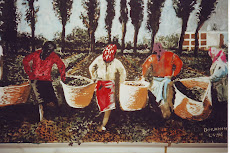

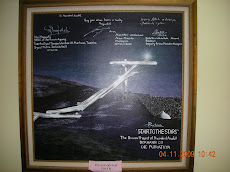





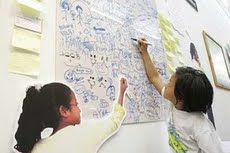

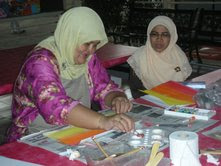.jpg)

